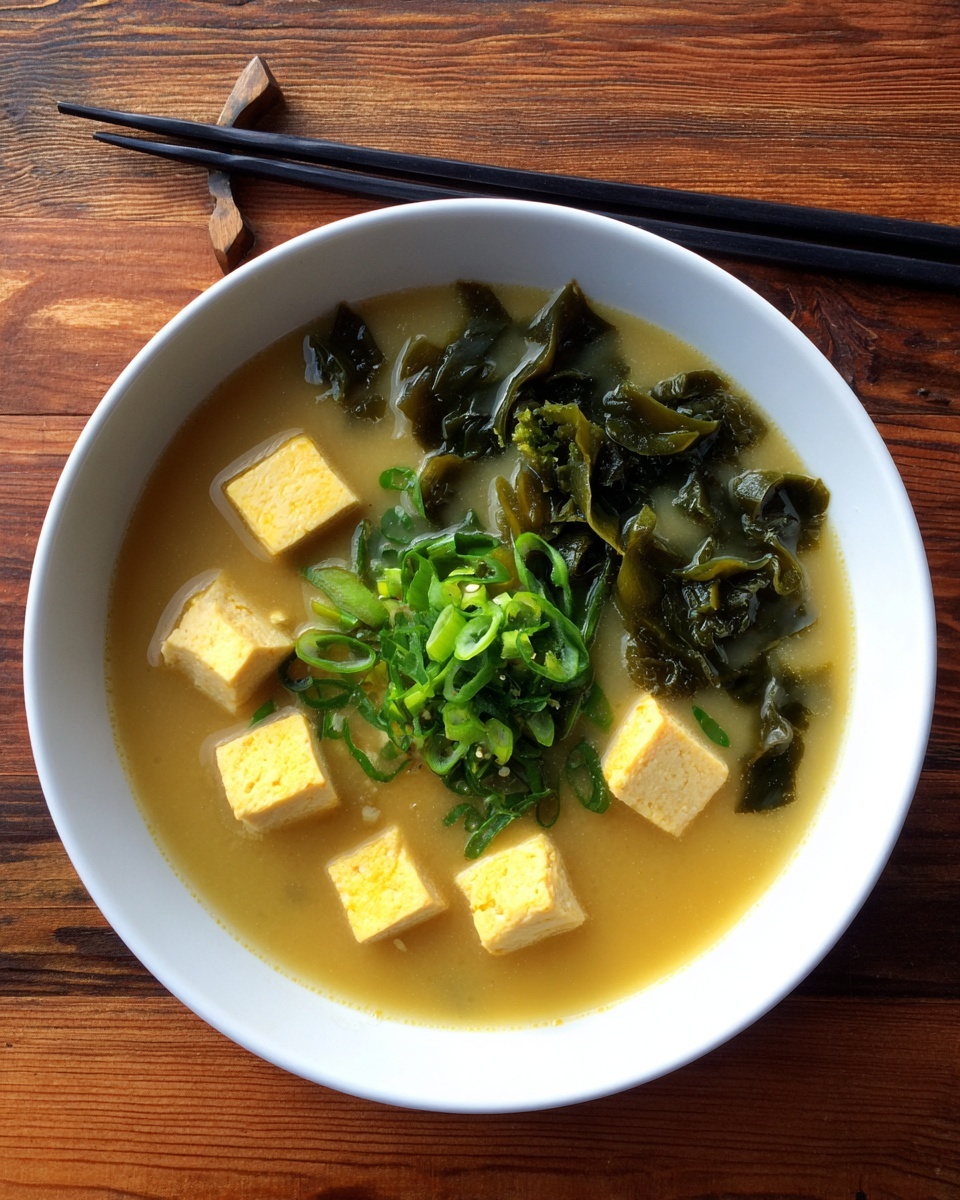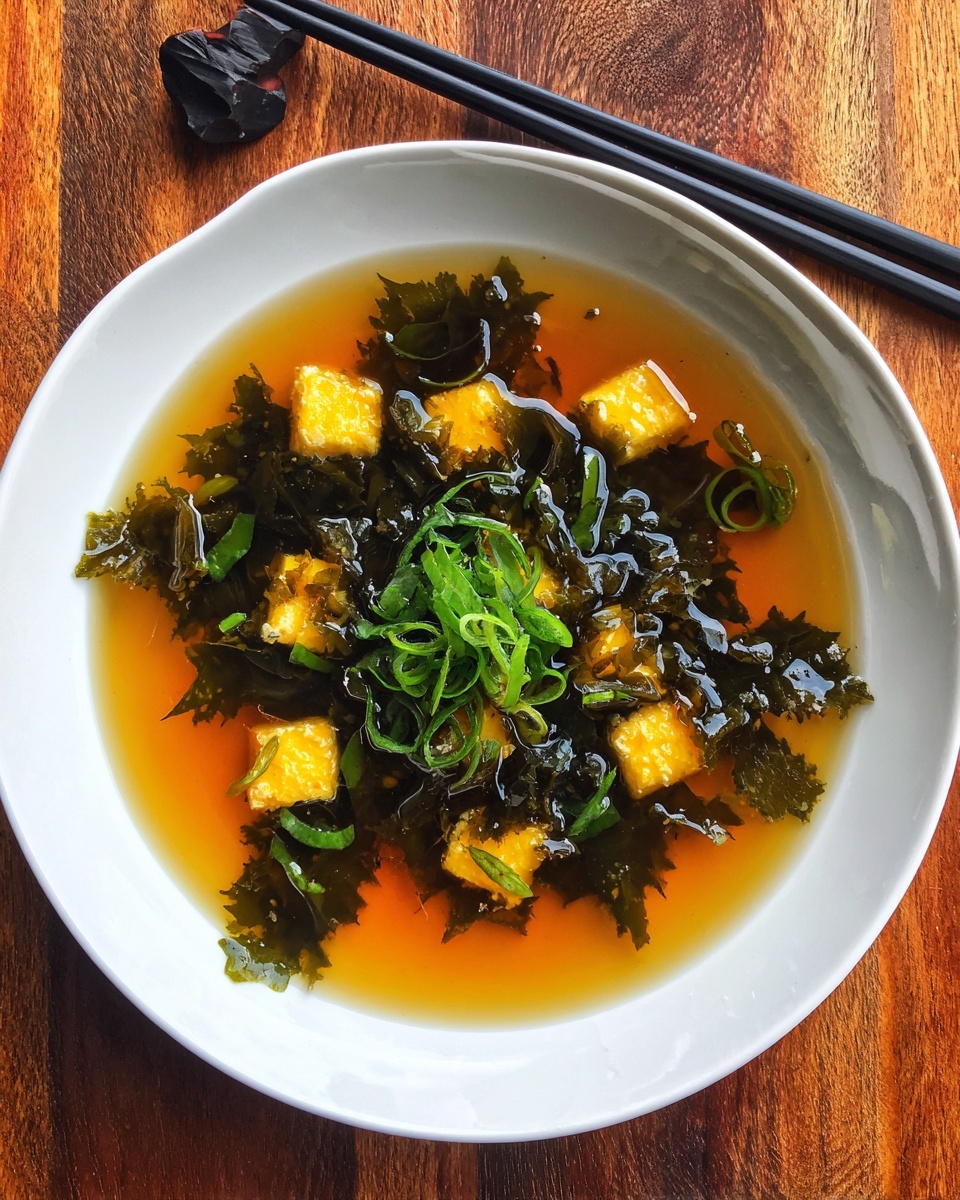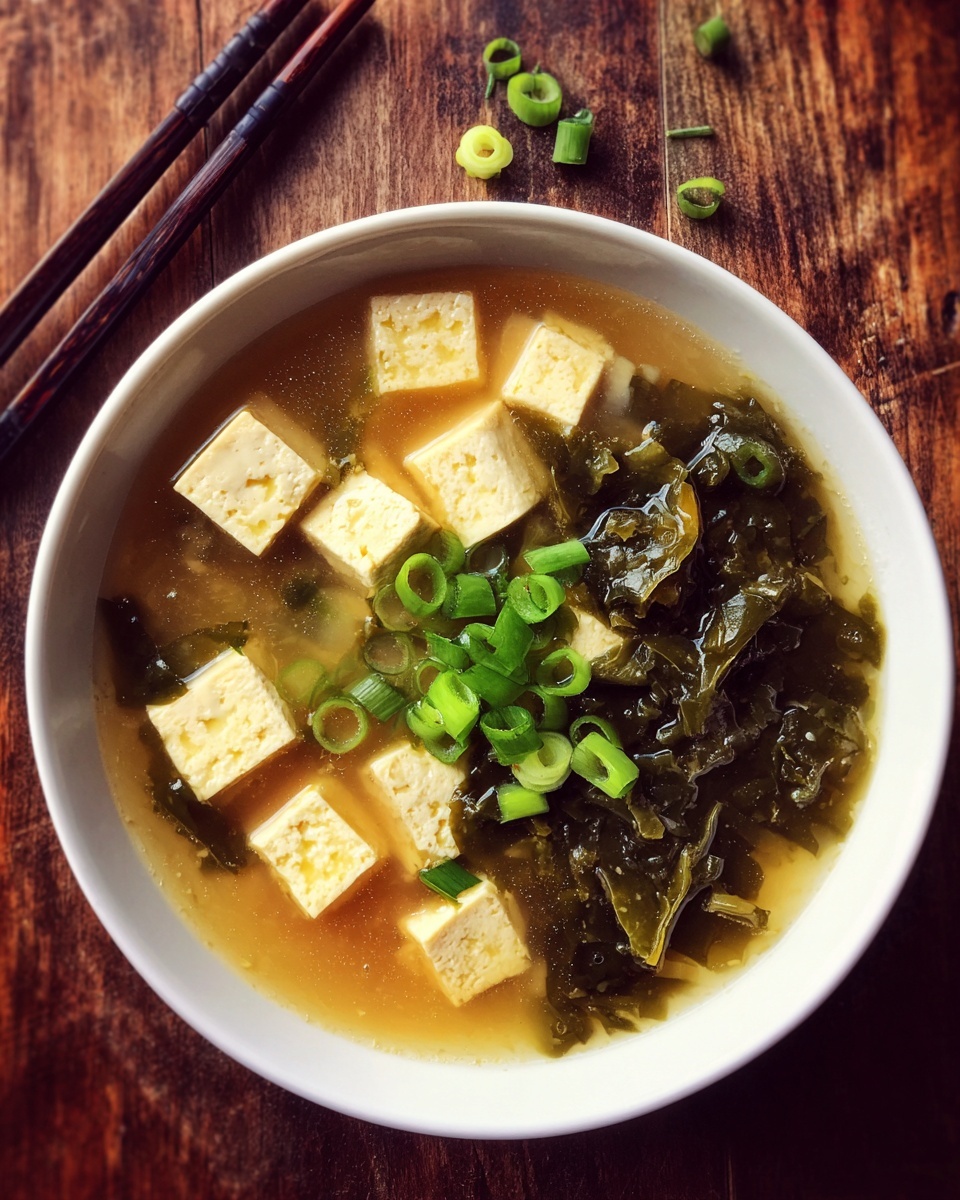If you’re craving a warm, comforting bowl that feels like a gentle hug on a chilly day, let me introduce you to this delightful Homemade Miso Soup with Tofu Recipe. This classic Japanese soup shines through its simplicity, marrying the umami-rich flavors of miso and dashi with silky tofu and vibrant greens. It’s not only incredibly nourishing but also a quick and satisfying way to elevate any meal or enjoy as a light, wholesome treat. Trust me, once you master this recipe, you’ll find yourself coming back time and time again to enjoy its soothing goodness.

Ingredients You’ll Need
This Homemade Miso Soup with Tofu Recipe relies on a handful of essential ingredients, each bringing its own magic to the bowl. From the ocean-fresh kombu and wakame that add natural savory depth, to the creamy tofu providing smooth texture, every component plays a vital role in creating a harmonious balance of flavors and colors.
- Water (4 cups): The base of the dashi stock, bringing everything together with a clean taste.
- Kombu (1 piece): Dried kelp that infuses the broth with a subtle sea flavor and rich umami.
- Katsuobushi (1 cup-packed bonito flakes): Adds a smoky, deeply savory note essential for authentic dashi.
- Soft/silken tofu (7 oz): Delivers a delicate, silky texture that contrasts beautifully with the broth.
- Miso paste (4 Tbsp): The star ingredient that brings salty tang and earthy depth; use about 1 Tbsp per cup of dashi.
- Dried wakame seaweed (1 Tbsp): Expands in the soup to provide a tender bite and strengthen the ocean flavor.
- Green onion/scallion (1): Adds a fresh, mildly sharp note that brightens each spoonful.
How to Make Homemade Miso Soup with Tofu Recipe
Step 1: Prepare the Dashi Stock
Start by gently soaking the kombu in 4 cups of cold water in a saucepan. Slowly bring the water to a boil, then remove the kombu just before the water boils to avoid bitterness. Next, add the katsuobushi (bonito flakes), let them simmer briefly, then strain your stock through a fine sieve or cheesecloth. This fresh dashi forms the soul of your miso soup, providing a clean yet complex flavor foundation.
Step 2: Prep the Tofu and Wakame
While the dashi is simmering, carefully cut the silken tofu into small cubes. Rinse and soak the dried wakame seaweed in water for a few minutes until it rehydrates and expands. This step ensures the textures are just right, with tofu remaining soft and wakame tender but not slimy.
Step 3: Combine Ingredients and Add Miso
Return the strained dashi to low heat, making sure not to boil it vigorously – that could destroy the subtle nuances of miso and tofu. Slowly whisk in the miso paste until it dissolves completely. Stir in the cubed tofu and wakame, warming everything through gently. Avoid letting the soup boil once miso is added to keep that fresh, vibrant flavor intact.
Step 4: Garnish and Serve
Finally, slice the green onion into thin rounds and sprinkle them over the soup just before serving. This bright garnish ties all elements together, adding a crisp edge that elevates this humble, soul-warming dish.
How to Serve Homemade Miso Soup with Tofu Recipe

Garnishes
While the classic green onion rounds are perfect, feel free to add a dash of toasted sesame seeds or a few slivers of fresh shiitake mushrooms for an extra touch of flavor and texture. These little touches make each bowl feel special and Instagram-worthy.
Side Dishes
Homemade Miso Soup with Tofu Recipe pairs wonderfully with light Japanese sides like steamed rice, pickled vegetables, or a crisp cucumber salad. For a full meal, consider serving it alongside grilled fish or a simple udon noodle dish. The soup’s mild umami complements stronger, richer dishes perfectly.
Creative Ways to Present
If you’re hosting a dinner or want to impress a loved one, serve the miso soup in rustic lacquer bowls or charming ceramic cups to enhance the warm, inviting experience. You could also include small dipping bowls with extra miso paste or chili oil for guests to customize their flavor.
Make Ahead and Storage
Storing Leftovers
You can keep leftover miso soup in an airtight container in the refrigerator for up to 2 days. Just be sure to store the soup separately from any garnishes to maintain their freshness.
Freezing
Freezing miso soup with tofu isn’t recommended since tofu’s texture can become grainy and rubbery once thawed. For best quality, enjoy freshly made soup or refrigerate for short-term.
Reheating
Reheat gently on the stove over low heat, avoiding a boil. High heat can strip the soup of miso’s vibrant flavors and alter the tofu’s delicate texture. Stir occasionally and serve warm.
FAQs
Can I use other types of miso for this recipe?
Absolutely! White miso (shiro) provides a milder, sweeter taste, while red miso (aka) offers a deeper, saltier profile. Feel free to experiment to find your favorite flavor balance.
Is there a vegetarian version of this Homemade Miso Soup with Tofu Recipe?
Yes! Simply omit the katsuobushi (bonito flakes) and rely solely on kombu for your dashi stock. The flavor will be lighter but still delicious and umami-rich.
What type of tofu is best for this soup?
Soft or silken tofu is ideal because it adds a creamy, smooth texture that complements the broth without overpowering it. Firmer tofus tend to break apart or feel too dense.
Can I add other vegetables to this soup?
Definitely! Sliced shiitake mushrooms, thinly sliced carrots, or even baby spinach work well for added nutrients and variety. Just add them during the simmering phase so they cook gently.
How do I prevent miso soup from becoming bitter?
The key is to avoid boiling the soup after adding miso paste. Keep the heat low and dissolve the miso gently to preserve its delicate, savory flavor without bitterness.
Final Thoughts
This Homemade Miso Soup with Tofu Recipe is one of those simple yet extraordinarily satisfying dishes that anyone can enjoy at home. It’s comfort in a bowl, packed with nourishing ingredients and beloved Japanese flavors that always bring warmth and joy. I genuinely encourage you to try it out—once you do, you’ll understand just how easy it is to create a delicious, soul-soothing soup that feels like a special treat every time.
Print
Homemade Miso Soup with Tofu Recipe
- Prep Time: 10 minutes
- Cook Time: 10 minutes
- Total Time: 20 minutes
- Yield: 4 servings
- Category: Soup
- Method: Stovetop
- Cuisine: Japanese
- Diet: Gluten Free
Description
This Homemade Miso Soup with Tofu recipe delivers a comforting and authentic Japanese soup made from scratch with flavorful dashi broth, silky soft tofu, wakame seaweed, and fresh green onions. Ready in just 20 minutes, it’s a warming, healthy, and easy-to-make soup perfect for any season or meal.
Ingredients
Broth Ingredients
- 4 cups water
- 1 piece kombu (dried kelp), approx. ⅓ oz (10 g), 4 x 4 inches (10 x 10 cm)
- 1 cup katsuobushi (dried bonito flakes), loosely packed (about 3 cups for stronger flavor)
Soup Ingredients
- 7 oz soft/silken tofu (kinugoshi dofu), cut into cubes
- 4 Tbsp miso paste (about 1 Tbsp or 18 g per cup of dashi)
- 1 Tbsp dried wakame seaweed
- 1 green onion/scallion, thinly sliced
Instructions
- Prepare the ingredients. Gather all the ingredients, rinse the kombu and soak the dried wakame in water until it expands and softens. Cut the soft tofu into bite-sized cubes and thinly slice the green onion into rounds.
- Make the dashi broth. In a saucepan, add 4 cups of water and the piece of kombu. Slowly heat over medium heat and bring just to a boil. Remove the kombu before the water boils to prevent bitterness. If using, add the bonito flakes, simmer gently for a few minutes to extract flavor, then strain the broth through a fine sieve or cheesecloth to remove the flakes. This freshly made dashi forms the base of your miso soup.
- Prepare the miso soup. Pour the dashi back into the pot and warm over low heat until it is almost boiling. Lower the heat and dissolve the miso paste in a ladle of hot dashi, then stir it back into the pot to prevent clumping. Add the cubed tofu, soaked wakame, and sliced green onion. Heat gently without boiling to keep the delicate flavors and textures intact.
- Serve immediately. Ladle the miso soup into bowls and enjoy it hot as an appetizer or side dish with your meal.
Notes
- Do not boil the soup aggressively after adding miso to preserve its delicate flavors and beneficial probiotics.
- The kombu can be reused to make a second batch of dashi if desired.
- You may adjust miso paste quantity to taste; red miso will give a stronger flavor compared to white miso.
- For a vegetarian or vegan version, omit katsuobushi and use kombu-only dashi or substitute with shiitake mushroom broth.








